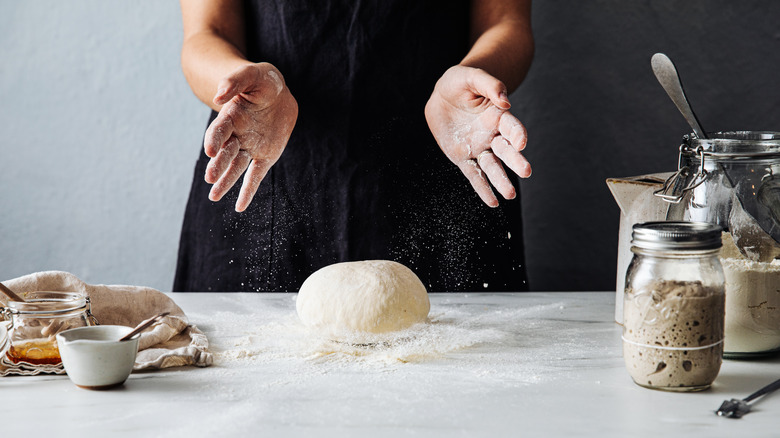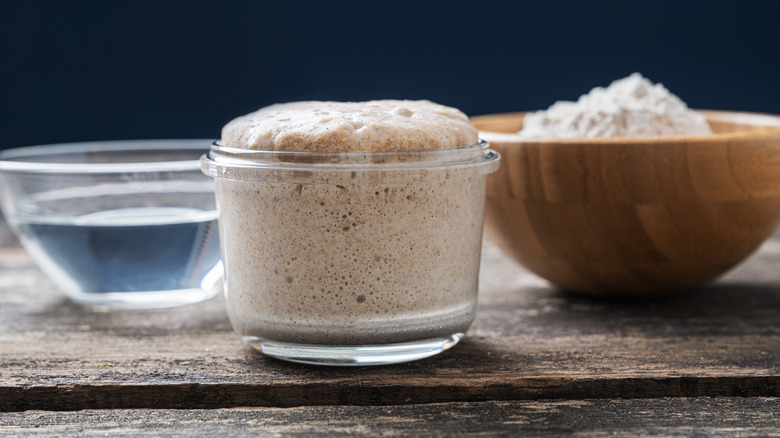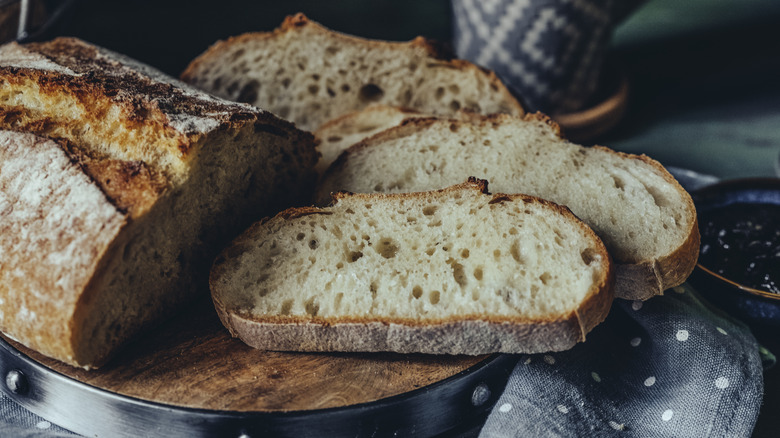What Is A Sourdough Starter?
Humans have been baking bread for thousands of years even when only the simplest ingredients were available, like flour and water. You can still make the most of these everyday kitchen ingredients to bake delicious, fluffy loaves, including more complex options like sourdough bread. But there are some extra steps involved for this kind, including having a sourdough starter.
Though it sounds complicated, a starter is really just a combination of flour and water that, over time, becomes a live fermented culture consisting of a stable balance of healthy bacteria and wild yeast. When mixed with water and left to ferment, the yeast and bacteria will thrive on the carbohydrates in flour. As fresh flour is added to the starter, these microbes then emit gases that allow the bread to aerate and leaven during baking. These microbial reactions also result in lactic and acetic acids, which give sourdough bread its tangy flavor, chewy texture, and subtly sour scent.
A starter needs to be regularly maintained with "feedings" of fresh flour and water to keep the healthy bacteria and naturally forming yeast alive and ready to use. That's the magic of this component though — as long as you feed and maintain it, you can keep it alive indefinitely and keep making more sourdough loaves.
Tips for making your own sourdough starter
Making your own sourdough starter at home is simple, but there are a couple of tips to follow to make sure it's a success and available for repeated applications. First, stick to a semi-regular replenishing schedule to ensure your starter is always ready for baking.
If you bake once every couple of weeks, you can keep your starter in the fridge in between feedings and simply add refreshment at least a day before making bread. If you cook less than once a month, freeze your starter and revive it a few days before baking.
Some types of flour are a better choice to kick off your sourdough starter than others. Bleached flour may eventually produce a satisfactory starter, but because bleaching eliminates natural microorganisms, it will likely take significantly more time to become active and ready.
Temperature is also important to keep in mind; starters tend to thrive in environments warmer than 68 degrees Fahrenheit. If your environment is cooler, use warmer water during the feedings, and wrap your starter in a towel or store it in an oven with the light on in the early stages of activation.
Alternatively, you can opt to buy a liquid starter from your local bakery or a reputable baking company. Many online stores also sell dehydrated starter kits. Simply add water according to the packaging instructions and get baking!
Reasons to add sourdough bread to your diet
Because sourdough bread rises naturally due to its yeast-filled starter (unlike many commercial breads that rely on baker's yeast), there are some purported health benefits associated with sourdough as a result of this distinction. Not to mention the fact that its ingredients are natural, fresh, and unprocessed.
A sourdough loaf may be a more gut-friendly option than many commercial bread alternatives. A 2014 study from the Journal of Food Microbiology found that, during baking, sourdough's fiber and plant compounds, known as polyphenols, become more easily absorbed by the gut and act as crucial fuel for gut microbes.
A 2019 study from Aging Clinical and Experimental Research also explored the effectiveness of sourdough as a choice for those who need to regulate blood sugar, such as people with diabetes. The bread's fermentation process, coupled with higher levels of dietary fiber than store-bought loaves, gives sourdough a glycemic index (GI) of just 54. This categorizes it as a low-GI food, which means it releases sugars into the blood gradually and doesn't spike blood sugar levels.



